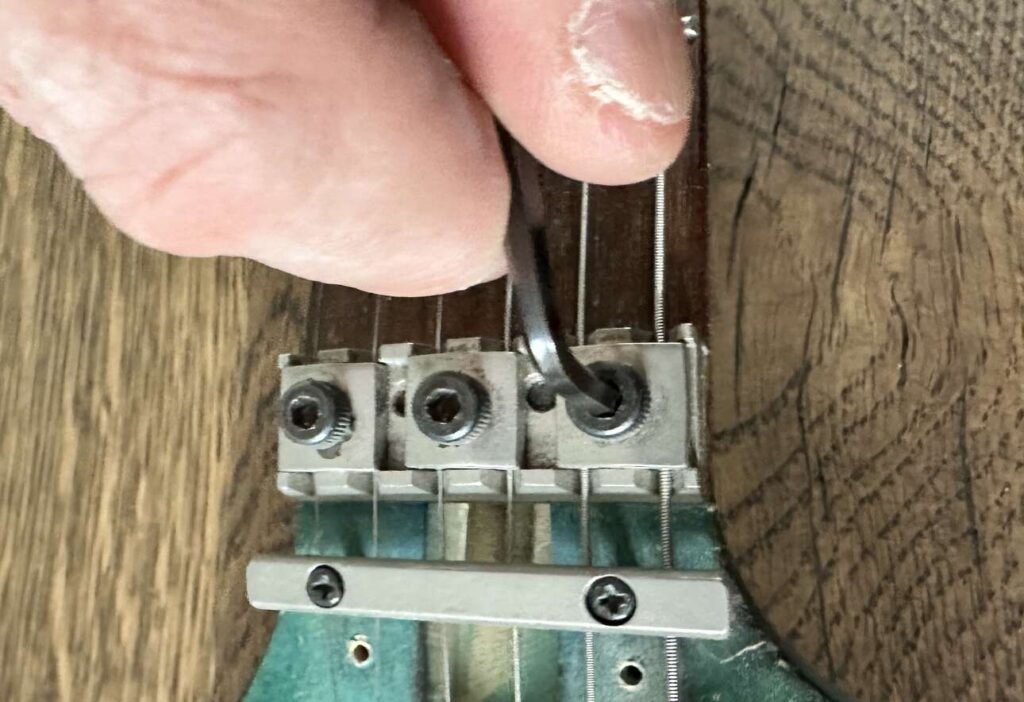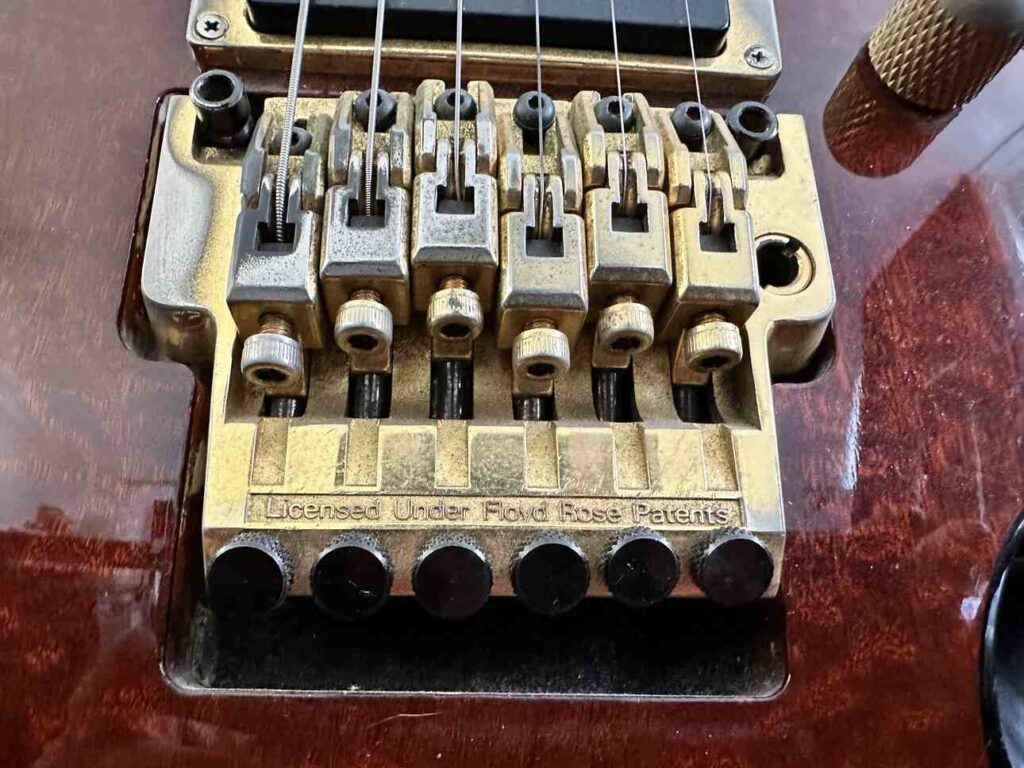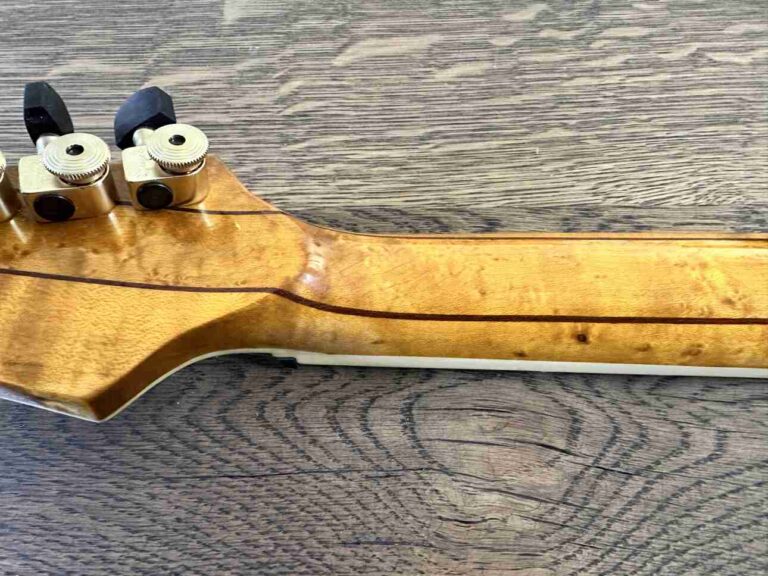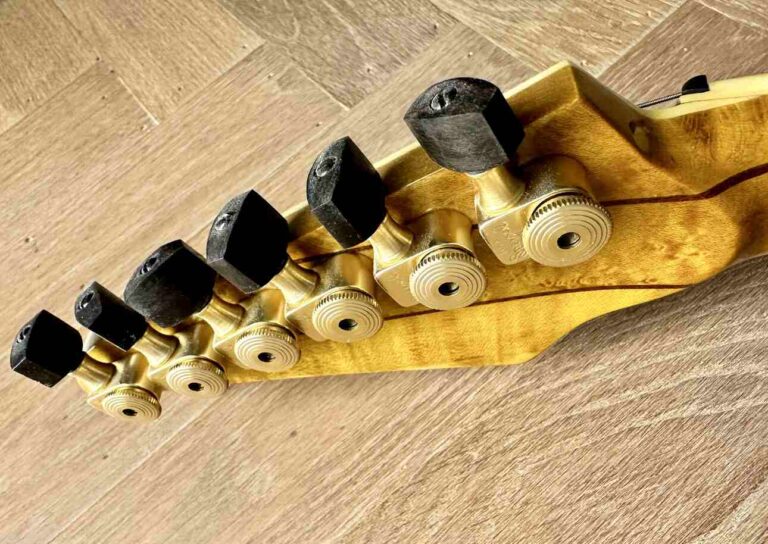How Hard is it to Tune a Floyd Rose Bridge? Tips for Success

Well, quite hard, I must admit. Tuning a Floyd Rose Bridge might seem tricky if you’ve never done it before. It really requires patience and practice. Especially if you’re used to standard guitar bridges.
I must admit, after all these years, I still hate tuning Floyd Rose bridges. I’ve been doing it since I purchased my first electric guitar back in 1995. Yes, I can do it relatively quickly, but it’s still a tedious chore.
But the Floyd Rose’s tuning stability keeps me using this type of bridge on my guitars.
Anyway. Hopefully, my experience and the information in this article will help you.
Before you start, it’s important to gather all necessary items. You’ll need a tuner, hex keys, and a bit of know-how.
The Floyd Rose setup involves locking nuts and fine tuners. These have advantages for sure, but they make tuning up tedious.
With a Floyd Rose, patience is key. The effort you put into learning to tune your guitar equipped with this type of bridge will make it easier to handle the tremolo and maintain the tuning.
Let’s have a look at the ins and outs!
Key Takeaways
- Understanding the Floyd Rose setup is essential;
- Using the right tools and fresh strings helps;
- Patience and practice improve the tuning process.
Preparation for Tuning
Preparing to tune a Floyd Rose Bridge requires specific tools and an organized approach. Follow these steps carefully to avoid any mistakes.
Tools You’ll Need
To start, gather your tools: a tuner and a 3mm Allen wrench.
A good guitar tuner could also be useful for accuracy. Consider an electronic tuner, which delivers precise readings.
The 3mm Allen wrench is used on most systems to tweak bridge components and the locking nut. The latter is critical; incorrectly securing it can cause instability.
Also, keep a pair of cutters nearby to trim excess string length. It keeps everything neat and tidy.
Initial Setup
First, remove the old strings if they are still on the guitar.
Carefully loosen the clamps that hold the strings at the nut. Use your wrench.
Next, install the new strings. Start with the low E string, going to the high E string.
Thread the strings through the tuning pegs.
Then, use the guitar tuner to check each string, making small adjustments until they are in tune.
Repeat the tuning process until all strings stay in tune.
Finally, lock the nut to keep the strings stable.

Restringing a Floyd Rose
Restringing a Floyd Rose bridge can be tricky, but with a systematic approach, it becomes manageable.
The steps below will help you replace guitar strings and get your guitar sounding great again.
Step-by-Step Restringing Guide
Remove the old strings. To speed up the process, use a string winder.
Loosen each string by turning the tuning pegs until the strings are slack.
With a pair of string cutters, snip the strings near the tuning pegs and bridge. Carefully remove the old strings from the guitar.
Next, prepare your new strings. Open the package and unfold a new string.
Feed it through the appropriate slot to attach it to the bridge. Repeat this for each string, ensuring the ball end is seated correctly.
Now, pull the string up to the tuning pegs. Pull it taut and crank the tuning peg using the string winder. Make sure the string winds neatly around the peg without overlapping. Do this for all six strings.
Once all strings are in place, it’s time to stretch them. This prevents them from quickly going out of tune.
With a Floyd Rose, patience is key
Stretching the Strings
Stretching the strings is necessary for stability. After attaching all strings, gently pull each string upward away from the fretboard. Do this along the entire length of the string.
This helps the strings adjust to tension and stay in tune longer.
Tune the guitar to the desired pitch using a tuner. After initial tuning, repeat the stretching process a couple of times.
Properly stretched strings offer better tuning stability.
After stretching, checking and tuning, the guitar ensures the strings stay tight and maintain their pitch.
Tuning the Floyd Rose
Tuning a Floyd Rose bridge means you need to pay attention to several things.
Let’s look at balancing string tension, using fine tuners, adjusting the bridge height and tilt, and achieving tuning stability.
Balancing String Tension
Balancing string tension is crucial for the Floyd Rose system.
Start by tuning one string at a time. When you adjust one string, the others can go out of tune due to the bridge’s floating system. This is due to the increased tension the tuned string provides.
It makes the bridge tilt forward a bit, altering the pitch of all strings.
This is exactly why tuning a Floyd Rose bridge can be a nuisance.
Once your string is tuned close to the intended frequency, use the fine tuners on the bridge. After tuning all strings, check their tension and adjust accordingly.
This process can take a while, as with each replaced and tuned string, the guitar detunes itself due to the bridge coming forward.
In other words, this might need several rounds of tuning. To help balance tension, you can use the spring system in the back cavity of the guitar.
Add or remove springs depending on the tension needed. Or adjust the tremolo claw by loosening it or screwing it tighter.

Using the Fine Tuners
The fine tuners are a key feature of the Floyd Rose bridge.
These small screws allow you to make minor tuning adjustments after the strings have been locked at the nut.
Turn the fine-tuner screws clockwise to raise the pitch and counterclockwise to lower it.
They are handy for making slight corrections without unlocking the nut.
Always check the tuning regularly, especially if you often use the tremolo bar. Regular use can affect tuning stability.
Adjusting the Bridge Height and Tilt
Adjusting the bridge height and tilt can improve both playability and tuning stability.
Check the bridge height by looking at the distance between the strings and the fretboard.
Use the bridge posts to make height adjustments.
Turning the posts clockwise lowers the bridge and raises it counterclockwise.
The tilt of the bridge is equally important. A bridge that is too tilted forward or back can cause tuning issues.
Adjust the screws in the back cavity to align the bridge parallel to the guitar body. This setup helps keep the strings in tune and the action consistent across the fretboard.
Frequently Asked Questions
What is the proper process for tuning a Floyd Rose to Drop D tuning?
To tune a Floyd Rose to Drop D, first, unlock the locking nut.
Then, lower the low E string to a D note. Fine-tune the other strings to remain in standard tuning because tuning one string affects the others.
Can you guide me on how to lower the bridge on a Floyd Rose without affecting its performance?
Lowering the bridge requires adjusting the two pivot screws. Turn them in small increments while checking the bridge height and maintaining the balance.
Make sure the bridge stays parallel to the body to avoid disrupting the guitar’s action.
What’s the best way to tune a floating bridge, including a Floyd Rose system?
Begin by tuning all the strings to the desired pitch. Then fine-tune each string using the micro-tuners.
Check the bridge’s balance throughout to keep it level. Perfect tuning may take a few iterations.
What are the steps to tuning a Floyd Rose guitar with a locking nut?
Unlock the nut clamps first. Then, tune the strings to the desired pitch.
Once done, lock the nut clamps back in place. If necessary, use the fine tuners on the bridge to make minor adjustments to keep the guitar in tune.
How do I restring a Floyd Rose bridge efficiently?
Replace one string at a time to maintain the bridge’s tension.
Insert the string end into the saddle and tighten the clamp.
Wind the other end onto the tuning peg, stretch it gently, and tune to pitch. Repeat for each string.
Can I tune a Floyd Rose to D standard, and what should I consider?
Yes, you can tune it to the D standard. But all strings should be tuned down a whole step.
Keep the bridge’s balance in mind. You might need to adjust the spring tension in the back of the guitar to keep the bridge level.






